The route of the 2024 Tour de France has been unveiled. It’s unusual because of the Italian start and the finish in Nice, it’s different because of everything else in between.
A start date of 29 June, a week earlier than usual to get clear of the Paris Olympics. Indeed it’s clear of France with an Italian start. Stage 1 has 3,600m of vertical gain, do we call this a mountain stage? It’s certainly tougher than last July’s Basque opener and that went to the GC contenders. It’s across the spine of Italy, Tirreno-Adriatico in a day, via Sanmarino or “Saint Martin” en français before a flat finish by the coast.
Stage 2 is flatter but has two ascents from Bologna to the San Luca basilica, the fierce climb used in the Giro d’Italia and the Giro dell’Emilia where there’s no hiding. Stage 3 is for the sprinters with a Fausto Coppi tribute along the way in Tortona, and for the record, the longest stage at 229km.
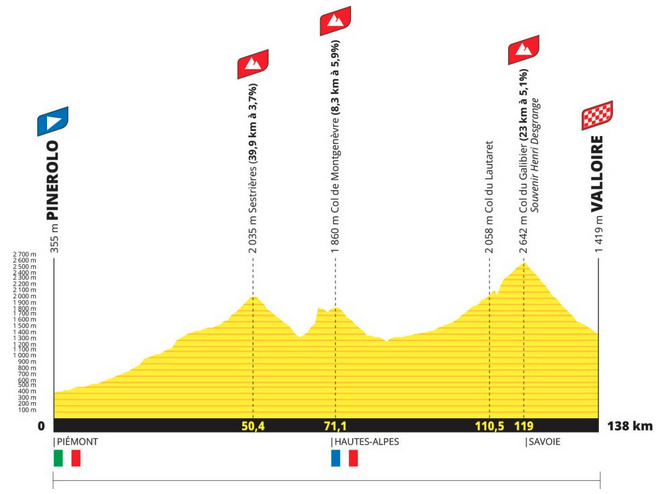
Stage 4 and the Alps already. Inevitable given the race has to get to France but they could have taken softer options. Instead it’s Sestriere and the Montgenèvre, they’re two long climbs you could drive a team bus up, ditto the Lautaret as well but you’ll have to park the bus here. The Galibier is very hard and a quasi-summit finish because if a rider can crest this point alone they’ve a good chance of staying away for the win in Valloire.
Stage 5 and the Tour turns its back to the Alps but unlike Wordsworth’s journey off the Simplon there’s no melancholy in leaving the mountains as the race will be back in no time. A bit like the stage won by Kasper Asgreen recently, this race rides through the Alps rather than over them, passing Chambéry for a probable sprint finish by the river Rhone in Saint-Vulbas, where Nacer Bouhanni won a Dauphiné Stage in 2016.
Stage 6 begins the gourmet phase of the race which could have journalists and podcasters in rapture as Macon’s famous for its nearby wines, Dijon’s given its name to mustard and so on, plus there should be a sprint to talk about. Stage 7 is an individual time trial, just 25km between Gevrey-Chambertin and Nuits St.Georges, names more often seen on a wine menu than for real. It’s probably enough to mix up the GC with a short climb along the way. If the Tour did wine stages this would be it, a day to celebrate Pinot noir in the absence, sniff, of Thibaut Pinot.
Stage 8 goes over plenty of rollers and one of those days where French TV will go big on the history perhaps leaving international viewers flummoxed as Colombey-les-deux-Églises is famous for Charles De Gaulle, the exiled war leader and two-time President who famously – in France at least – came to see the Tour go past in his retirement and the race stopped to pay tribute to him, the first and only time it’s halted like this (there have been roadside protests, rider strikes and other incidents but not a decision just to stop, chat and then race on). Anyway expect to hear this story and get helicopter shots of the Lorraine Cross before the sprint trains gather speed.

Stage 9 is the most northerly stage, and starts and, jamais Troyes sans deux, finishes in the same place, both curiosities but the headline is 14 sections of gravel totalling 32km and nine are kept for the final 70km. Gravel is a catch-all label for unpaved roads, here it’s the same roads used by the women in the 2022 Tour when Marlen Reusser won and Mavi Garcia had a nightmare. It provides spectacle in the moment – perfect for a Sunday far from the mountains – and also a talking point: a chance to dust off the old “does pavé gravel belong in the Tour de France?” debate. Some GC riders will fear this stage – Jumbo-Visma or whatever they’ll be called have criticised it already and the fear of the fear will heighten anticipation. There is a random element where, the wheel of fortune for some might spin, for others it’ll puncture at the worst moment. The hardest part of the stage is in the first half.
After a rest day on the banks of the Loire in Orléans Stage 10 goes to St. Amand-Montrond, which has hosted the Tour and Paris-Nice alike. A sprint stage? Surely, unless the wind gets up and the organisers have included several changes of direction in the course towards the end with this in mind.
Stage 11 is a massif central mountain stage with 4,350m of vertical gain, and a share of this comes among the lumpy roads at the start where there’s bound to be a fierce battle to get in the breakaway. The more obvious climbs at the end are familiar, the roads here are identical to the finish in 2016 when Greg Van Avermaet took his pre-Olympic masterpiece. It can be a GC day too, the Pas de Peyrol is a stiff climb.
Stage 12 and Stage 13 are suggested siesta days with the dreamy Rocamadour along the way. You’ll want to set an alarm though as the sprint finishes promise to be hectic. The race reaches the halfway point here and there’s probably only one more sprint stage left so these days have to count and the second one to Pau has some small climbs late on.
Stage 14 is the first of two days in the Pyrenees and there’s a dash across the plains to Lourdes and up the Gavarnie valley to tackle the towering Tourmalet. The charming Hourquette d’Ancizan is next before a descent to the valley and only a few kilometres on the valley floor before the surprisingly hard climb to Pla d’Adet with long 10-12% ramps at the start.
Stage 15 has 4,800m of vertical gain, the most of all the stages but here spread out over 198km and a 14 July festival. It’s up the Peyresourde via the steeper western side before the Menté and Portet d’Aspet via their steeper sides too. Next is the tricky Col d’Agnes (pedants: it’s not Agnès, and sort of rhymes with Anne) which crosses over to the Port de Lers. A descent in two parts, the steep bit past the waterfall then it flattens out and then comes the valley floor, all plenty of time for the final drinks and gels. The Plateau de Beille summit finish has been called the Alpe d’Huez of the Pyrenees but that’s a stretch, it does start steep and has some wide hairpins but that’s about it, no ski resort at the top, just a car park – there’s a building… but it burned down recently – and no comparable views on the way. Selective though.
After a rest day in Gruissan where the mayor is Didier “the little prince” Codorniou, a top rugby player in the past it’s off to Nîmes for Stage 16, a likely sprint finish but with the obligatory mention that the Mistral wind can disrupt things, especially through the Pic St. Loup vineyards.
Stage 17 could be a stage of the Critérium du Dauphiné with the long valley road from Nyons to Gap, the Col Bayard and then the combo of the Col du Noyer and the Superdévoluy… the finish did feature in the 2016 Dauphiné, and then as now the Noyer is the superior climb, breathtaking twice over for the scenery and the 13% section before the top.
Stage 18 could go to the sprinters as it’s not a mountain stage even if it’s in the middle of the Alps. But by now anyone who weighs 70kg or more knows this is their last chance for a stage win and teams will send rider after rider in the breakaway, think of last July’s hectic stage to Champagnole won by Matej Mohorič for the template. It rides past the Serre Ponçon lake, scenic for cyclists and a spot for kitesurfers to watch for the wind before the Demoiselles Coiffées climb before the finish 3.9km at 5.2% to split things up further and not the main road to Barcelonnette but a side road too.
Stage 19 has 4,600m of vertical gain which is beaucoup for just 145km and where the opening 20km are flat. The Col de Vars is much harder than the 5.7% average suggests, you can spot the flat middle section and the opening part to the Col de la Viste is more like 10%. Then comes the mighty Cime de Bonette at 2,802m which is over an hour of climbing and a good part of this above 2,000m altitude, daunting and normally a slog but the short distance stage might tempt moves some otherwise Isola 2000 is the most of the Col de la Lombarde and a steep but steady start to the ski station used by plenty of Nice and Monaco pro cyclists for altitude training.
Stage 20 and plenty of déjà vu from Paris-Nice on a day with very little rest. On paper this promises more fireworks with long climbs and twisty descents. But could it be a stage too far if some GC contenders sit tight fearing the following day’s time trial? Or the second order effect that they might hold back on Stage 19 too so that they have reserves for Stage 20 in case they’re needed here and for the TT, a scenario we’ve seen in many a back-loaded Giro; a flat stage would be a harder sell. Fingers crossed it’s close on GC and everyone’s up for it. It could be easier in July than March with improved form, it could roasting hot too.
Stage 21 and a time trial via the Col d’Eze, more the ending Paris-Nice than the Tour. Just in case you’re wondering why the Tour de France finishes in Nice instead of Paris, it’s because of the Olympics, not so much a calendar clash, more the Tour finishing elsewhere gives Parisian policiers a rest before a busy period.
This is no parade-criterium stage but could be the race decider, that’s the dream scenario. It’s first time the race has ended with a time trial since 1989 when the Tour de France celebrated the 200th anniversary of the French revolution with a journey from Versailles to the capital. The profile just doesn’t do the course justice, no way is it a level climb up and a fast descent back down, it’s more technical with plenty of rhythm changes and where taking the right line downhill wins time.
The Verdict
A unusual start and not just because the Tour treads on the Giro’s toes in Italy, things start with what could be labelled the hardest opening stage of the Tour ever and the Galibier pops up three days later. Just writing up the notes above took twice as long as usual because of all the details along the way, this is a very lively Tour with the Galibier on the first Tuesday, the Bonette two and half weeks later.
Seven sprints but we’ll have to see more detail, to mix of dragster finishes for Fabio Jakobsen and uphill dashes for Mads Pedersen or Arnaud De Lie isn’t clear yet, Jasper Philipsen can handle most of this though and Mark Cavendish will be waiting for any opportunity.
Yet it’s not quite as mountainous as last year, three fewer categorised climbs of 2 or above and 52,230m of vertical gain, about 3,000m less than last year which is still higher than the average for the past ten years. Crucially all the big summit finishes and some of the preceding climbs are long steady ascents, as opposed to last summer’s wilder, more irregular climbs (think Cambasque, Joux-Plane, Loze), in short more altitude and less attitude. Two time trials totalling 59km make this, just, the most in the last ten editions too.

The obvious contender is Jonas Vingegaard just as the winner of the previous two editions. But the course suits him with the two time trials and crucially the long steady ascents too, as the Dane seems to be at his best when he’s got his team riding high tempo to crack rivals. Tadej Pogačar’s already said “I can’t wait to be there” but the question is whether he’s tempted by the Giro and then maybe spending July picking off stage wins or does he target the Tour outright? If so he might like the gravel stage more than others. Primož Roglič doesn’t get many of the sharp ramps he’s so good on and riding with a new team might be an issue although he’s as likely to stay stoic and keep on winning as he tries for the one stage race he’s yet to win. The intriguing prospect is Remco Evenepoel who’ll fancy the time trials and crucially if he’s got to do long climbs, here are linear, diesel-style ascents and even if his team mates are long gone, his bid to become a grand tour contender is fascinating to watch.

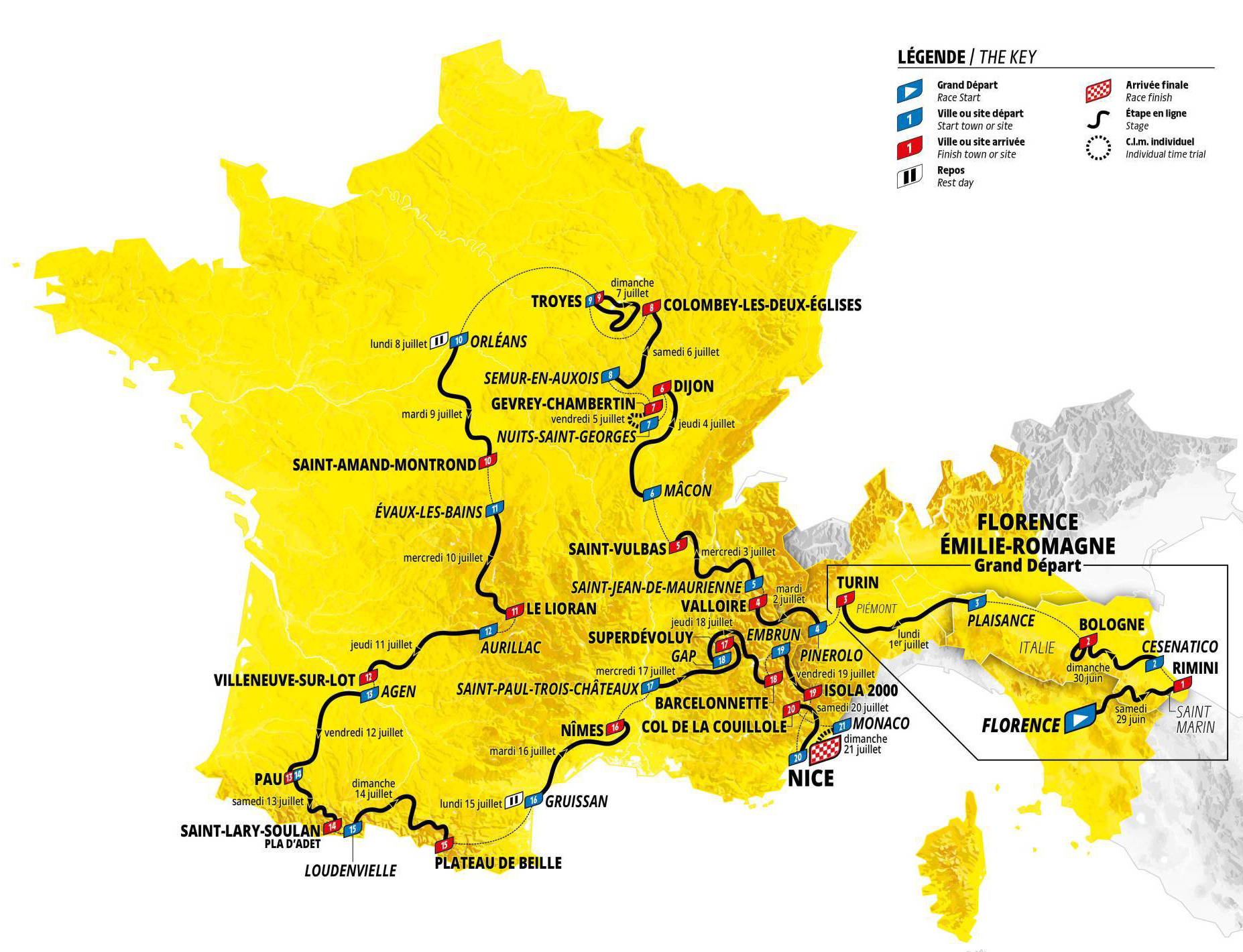


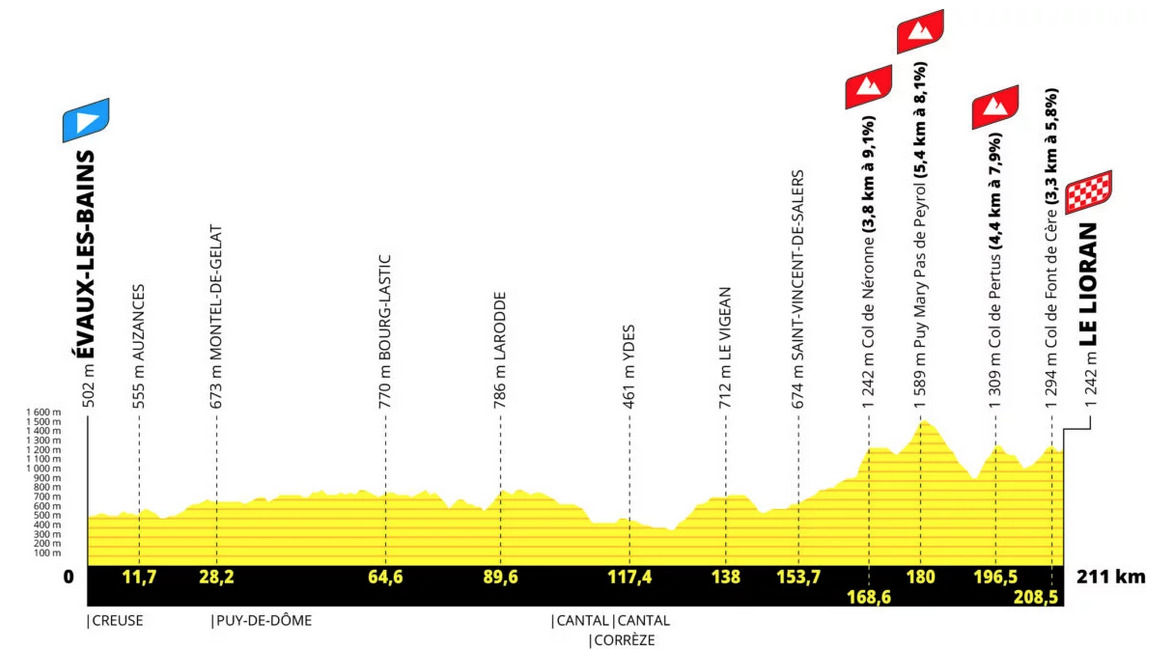
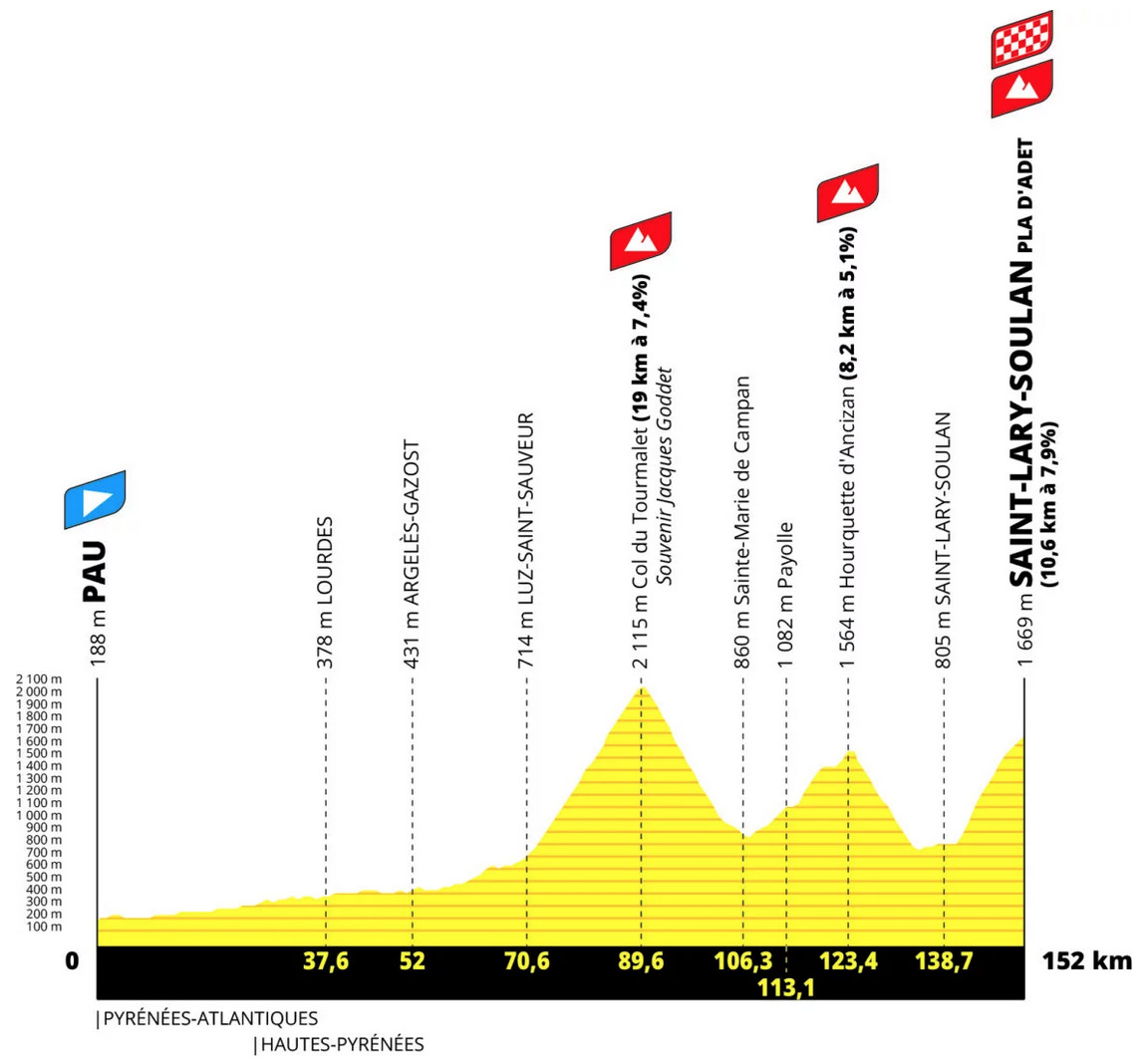
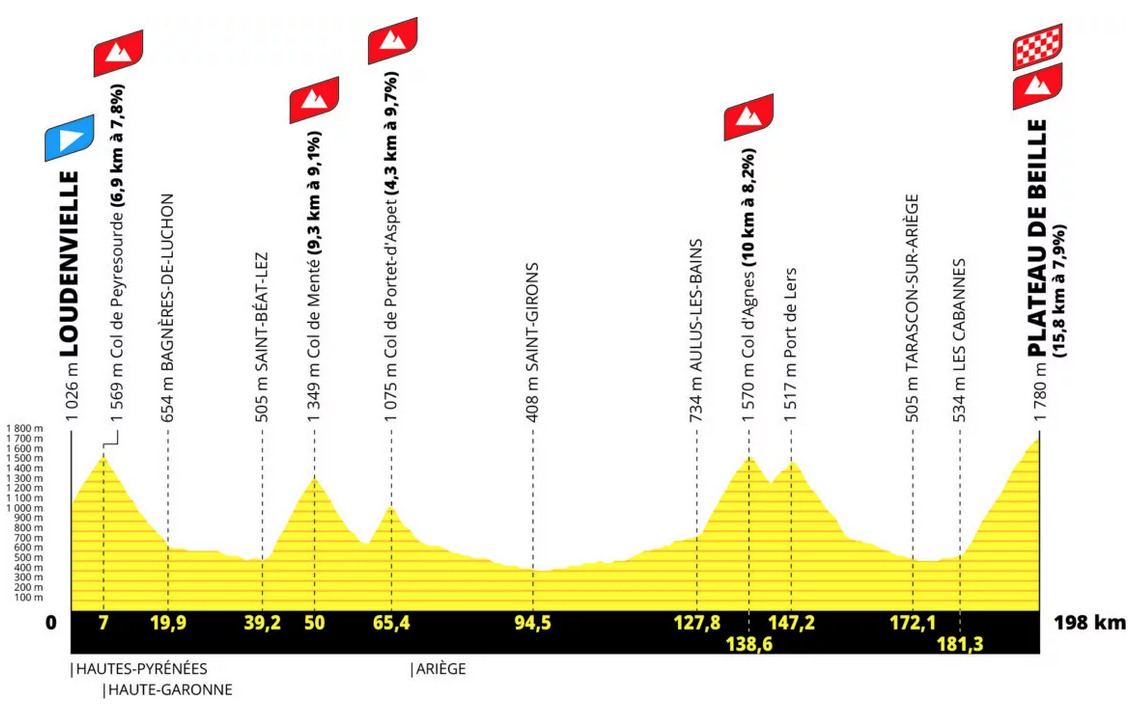


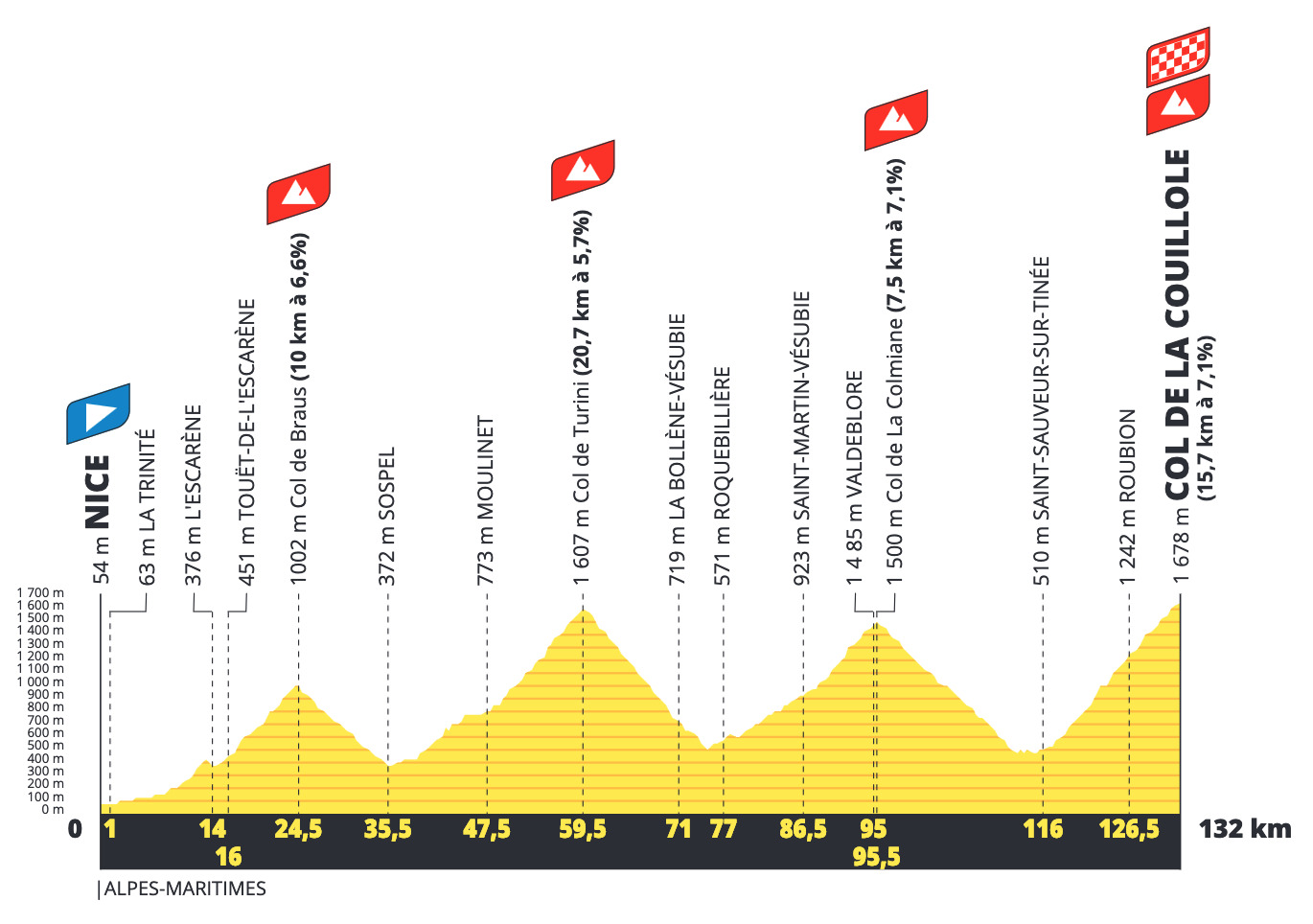
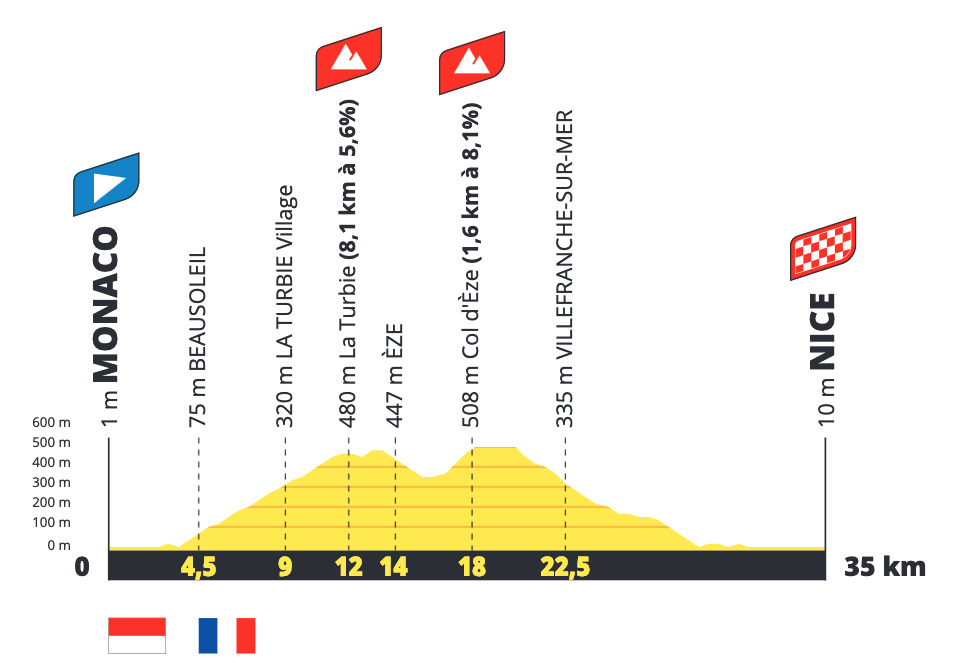
I noticed the profiles indicate that the Souvenir Henri Desgrange awarded is for the Galibier…surely it should be the Bonette?
There’s a Desgranges memorial on the Galibier so the tradition but maybe not the fixed rule is that if the race crosses the Galibier then it’s awarded here, if not the Galibier then the next highest climb can be used, as long as it’s not the Tourmalet as that’s reserved for the Jacques Goddet prize.
How nice to see a real and substantial final stage instead of riders trundling along sipping champagne before a brief city-centre crit.
The Troyes – Troyes stage will be interesting. Do the gravel sections ressemble Paris – Tours’ chemins de vignes? If so it could catch out the unlucky and also those ill-at-ease off road. (the IR play on jamais deux sans trois is appreciated)
When do we get the detailed route maps? As we have the kms the detail must be largely decided.
Detailed route maps come out in May, although it seems the final version of the route is signed off in about March, there can be one stage with a roundabout or not etc and the race gives out official route details to teams and others in March/April.
How hard is the gravel? I need to find out, lots of the route is familiar but this might be useful for a recon ahead although the state of the roads can change as they’ll do some works in time for the race. Otherwise, yes, they’re similar to the Paris-Tour ones, often flat and used by farmers. There are some sections from the women’s race which had loose gravel on top and pointy rocks jutting out below but there’s plenty more for next summer. A quick look suggests some could be quite narrow too.
Looks to be an interesting and different/difficult Tour. A nice (no pun intended) last stage instead of the usual. Looking forward to it, see you in June.
Thanks, yet again, INRNG for your efficient and informative analysis. It’s a bouncy parcours, to be sure. My only quibble is it’s now 3 years since the north / west of France has partaken. The boucle is increasingly squashed!
“Next year”, ie 2025, and the race is going to start in Lille and traverse to Brittany. As you say the race has really missed out on large parts of the country and this should be corrected soon.
All the annoying annual “The Tour doesn’t cover all France” critics may want to have a look on this site
https://www.velowire.com/article/1121/en/the-tour-de-france-doesn-t-visit-the-whole-of-france–in-fact-it-does–over-time—-the-historical-map-with-the-tour-de-france-parcours.html
And may recognize that some of the whiter spots on this map got kind of covered with this years route
Thanks you for that, I was only looking for a bit of year-to-year balance (and am admittedly nostalgic for the Tours that really did a veritable ‘Grand Boucle’) but, as the map nicely points out, over time the event covers most of the hexagone. It also shows that ‘le diagonal de vide’ applies to the TdF as well as modern demographic France.
That’s a useful piece of data analysis.
Someone was talking about the “shape” of the race for the Giro the other day and I think there’s a form to the map in recent years, it might well visit the north from time to time but the last 10 years have seen the race spending more time below the Bordeaux-Strasbourg line, even if it makes up for this from time to time. 2025 could well look a lot like 2015 or 2018.
Sadly a three week Tour which insists on a foreign start, wants shorter stages and which needs to include classic climbs in the Alps (Iseran, Télégraphe, Galibier…) and Pyrenees (Tourmalet, Aubisque…) will alays find it hard to give the North equivalent coverage – and that’s without the Ventoux etc. Without the foreign starts it would be easier though they seem part of ASO’s growth strategy.
I admit bias living in the Moselle.
Not each and every of them will end up eventually in a bunch sprint, come July, but you listed eight, not seven above as “likely sprint stages” (3, 5, 6, 8, 10, 12, 13, 16). Well distributed, anyway.
Having read several articles recently saying Florence has too many tourists & they are taking steps to try to control numbers, surely hosting the Tour de France is only going to bring in more tourists!
Florence was in “accidentally”, as it was the TDF which wanted it as part of an agreement which actually was strongly based in Emilia-Romagna.
Thanks. It did seem odd if Florence was complaining about tourists on the one hand & paying for the Grand Depart on the other!
Florence still want tourism but they want to manage it and even change it a bit. Places with “over tourism” problems like Florence, or Venice, Kyoto etc have the paradox of being very dependent on tourism so the mayor etc has to keep supplying this… but also finding better ways to manage the crowds in particular places.
Maybe if they can attract cyclists to the region then this won’t overcrowd the Uffizi and Ponte Vecchio but the town won’t suddenly find hotels full and cyclists heading out into the hills and locals getting a breather; it also gives town halls a good reason/excuse to put in cycling facilities like bike lanes. Or just use the TV footage with the helicopter shots to show off more things which can help attract tourists to more areas.
I was thinking of the influx of visitors coming to see the actual Grand Depart, as most of them will surely want to be at/near the start in Florence, rather than the long-term possible effects.
Florence might be one of the few cities where hosting the Tour actually reduces the number of visitors because teams, etc., block book hotels and make it more difficult for most visitors to come.
It would be rather amusing if that happened!
Still lacking a top-level fondo factor from several POVs and some more good middle-mountain stages which weren’t only about the last 40 kms… after the Italian ones, I mean (stage 20 isn’t “just” middle-mountain). An excess of hilltop finishes, too. That said, a huge further step forward compared to recent editions and a good route, all in all. The 2024 Giro looks even more mediocre for their lack of courage cutting down sterrati and climbs to make the course more… what?… friendly? Friendzone (to Pogi)?
Even the ASO is more capable of creating good stages on Italian soil than the Giro organisers. Another very promising and exciting Tour profile – very well balanced, always looking for new roads and exploring different regions and adding a factor like gravel or cobbles. Whoever is responsible for designing the Giro course should get the sack because they do not stand a comparison to the Tour based on the last years.
Barring the detail that the Italian stages weren’t drawn by ASO, you’re surely right about this edition, less so if you include previous ones for at least two reasons, i.e., we’ve had a good deal of poor TDF routes, *and* the Giro had excellent courses in, say, 2019, 2020, 2021; plus, 2022 or 2023 were good, too, at least on paper, with just a couple of minor mistakes which became more relevant only with hindsight, and depending on other circunstances, like the Hansen farce.
Just as a little test, you might have noticed that your appreciation of the 2024 TDF above could mirror perfectly the 2023 Giro, unlike, say… the 2023 Tour, LOL.
All that said, the 2024 Giro route really loses any kind of direct match against the corresponding Tour edition. Let’s just trust in ye ol’ good truism “riders make the race”.
Not a big fan of gravel – bit of a lottery with punctures, but at least the early season races with some gravel will get a lot more attention and GC guys turning up – Strade Bianche, Jaén Paraiso Interior etc.
Will Remco do the Tour? I think a lot of people want thim there, although if I were him, I’d do the Giro and wait until 2025 when the Tour is in more “Remco country” in the north of France. (cobbles probably instead of gravel too)
It’s not really like Strade Bianche needed any push to its startlist 😛
If riders can’t handle a bit of gravel, then they don’t deserve to be a GT winner; it’s just as fair a test as ITT or climbing……Far too many are one dimensional.
And punctures aren’t always ‘bad luck’; a combination of poor equipment choice, and line choice off-road can contribute to them.
There’s plenty of time for riders to get used to it between now and July.
I’d think if Remco wants to target the Tour in 25, he should definitely do the Tour in 24 with less expectation and learn the ropes…
It’s curious to me how some decry gravel as being against the tradition of road race cycling.
When I muse at old pics of the early warriors on Ventoux or the Torumalet, it appears rather gravelly under-tyre!
Agreed. I guess one could call it a chicken-egg thing but the advent of short-reach brakes pretty much killed-off putting decent-sized tires on a bike so it would be OK on unpaved roads, so unless it was Paris-Roubaix, that was that.
As much as I’m NOT a fan of hydro disc brakes, at least they freed us from the restrictions of all those gawddamned short-reach brake calipers! My favorite bike has ’em…and worse, the mounting points are extra low, making 25 mm tires the fattest I can use 🙁
+1 My understanding is that the idea behind Strade Bianche was to return to roots a bit.
The voices against this tend to be the team managers and riders going for GC. We can see why, they spend huge parts of their budget on a top rider and riders spend many months working for a goal and then – bang – the GC bid can go down the drain. A rider who has a lucky day can go on to get a good result and with a big contract, and vice versa. They want to control things as much as possible, they ride in train formations, plan a lot, do their recons, it’s risk management on wheels…
…and not the stuff of dreams. Many watching want a lively race with surprises.While the likes of Jumbo and Quickstep are complaining about the gravel, I can’t help feel they ought to find this stage advantageous, Vingegaard can have Van Aert, Laporte, Van Baarle and more to help while others with more fragile GC ambitions to begin with probably have a greater chance of being undone here.
These voices make me wanna campaign for even MORE gravel.
Not even the unwritten rules of ycling has a rule that everything has to worked as planned for big budget teams. The opposite is true. Get on your bike and pedal and if it’s too hard for you, don’t.
If i want formalistic approaches and outcomes. I’d watch German Bundesliga with Bayern becoming Meister for the 3454th time in a row. Go Snorefest!
Dortmund won it in both 2011 and 2012.
German football has a long way to go before it rivals Scotland for tedium.
No team other than Celtic or Rangers has won since 1985.
That’s what happens when money becomes the dominating factor in sport, venture capitalism fans.
Capitalism doesn’t create competition, it creates monopolies.
Isn’t cycling always a sort of lottery when it comes to punctures? Part of the sport is deciding on what equipment to use, no? Slap on some tougher tires for the rough stuff…same as Paris-Roubaix. I think J-V whines against the unpaved roads because they’re against ANYTHING that reduces the watts/kg advantage they think their man has vs a complete cyclist like Pogacar. These “numbers riders” are just that, big numbers with little skill in actually RIDING a bicycle rather than just pedaling one. Evenepoel is another one in the same mold as was Froome though he certainly improved in this area over the years.
“Whines”?
“Gravel is, for me, not necessary. I would not put it in a race such as this. The luck factor is getting too big,” said Jumbo-Visma boss, Richard Plugge. “On the other hand, it’s part of it, and we have to deal with that. The rest of the parcours is brilliant.”
Jonas Vingegaard: “It will be a new experience as it will be the first time I ride on gravel during a race. It’s a day where you can lose more than you can gain. We will have to make do with the choice of the course builders.”
Anyway, if road cycling was a sport as rich in stats, as, say baseball, we would be fortunate enough to know whether punctures in gravel stages are indeed so much more numerous than in asphalt stages, how many of those punctures are decisive and, possibly, even to what degree those punctures are avoided by teams or rider that choose tougher tires.
(My guesses would be: (1) Significantly more common, (2) Fewer than we may think, but still far too many, and (3) Perhaps surprisingly, not to any great extent.)
If Vinny wins again in 2024, I’d put money on there being cobbles in 2025. They did the same with Froome. The worst thing for the TDF is inevitability.
As the Tour is supposed to start in Lille in 2025. it seems that “the cobbles” might well be on the menu again. The irony about Froome and “the cobbles” is that he crashed and broke his wrist in the stage before the cobbles in 2014.
Thanks for the write-up Mr. Ring!
Imagine the excitement if Vinge, Pog and Rog entered the last day TT with less than a minute between them. So many previous story lines converging. I’m sure the organizers have that as a dream scenario.
That’s the dream scenario for fans and the organisers alike, race director Thierry Gouvenou said yesterday it’d be great if it’s on “a knife’s edge” going into the final stage. We’ll see.
Looks like a good route to me and the fact that J-V doesn’t like part of it just makes it better!
Gotta start thinking about going north to see some of “TdF in Italy” (which will bring back memories of Sestriere in 1999) and then the GIOS Raduno that might coincide with TdF passing near Torino.
Vive LeTour! 🙂
Thanks for the quick analysis! I’m looking forward to reading how the Demoiselles Coiffées climb got its name in your previews next summer.
It’s a rock formation, can save the details for July. I remember the race has been past before… the Tour as often a good geography teacher.
Will Stage 1 pass through Ponte a Ema to honor Bartali? I can’t find the specific route.
Yes it will.
Awesome! Thanks
Demoiselles Coiffées, I don’t know the climb but I have sampled the wine of the same name. Really wouldn’t recommend it.
I really want to go see a pair of stages for real. Any suggestions on where to go please?
Kirsten – a tough ask without knowing how you’ll travel, how you’ll get to your viewing spot(s) and how much time (and money) you have to spend. I’d suggest somewhere where it’s steep so you can see ’em do more than just whiz past in a blur to start, but IMHO ANY stage live is better than any stage on TV. Vive LeTour!
It’s a hard pick but at the same time you can’t usually go wrong, there’s no right or wrong answer.
I’d almost like think of things the other way around, not where to see the race but just where you’d like to go. For example my big tip for anyone going to see a stage is that they’re going on a big picnic first and at some point a bike race will flash by, so pick a nice spot, bring the right supplies (food, clothes etc) and then enjoy the caravan and race. So with this in mind, think if there’s region you’d like to visit, a place you want to see and how you’d get there etc.
That said the time trial stage can be good as it’s a longer experience and if you pick the right spot you can just about tell who is quicker. The start and finish areas can be closed off in parts but there can be things to see, although I’ve not been post-pandemic to see how the paddock works, if fans are really kept away.
The mountains are majestic of course but harder to reach, maybe even more so this year with some more remote climbs in the Pyrenees and Alps alike.
Nice also makes for a good base with several stages and depending where you travel from, good air, road and rail connections.
Just want to counter the chrono idea – if that’s all I could watch live, in-person, I’d stay home and watch ..er…snore…on TV. Unless I had an unlimited supply of good French wine that is…:-)
Personally, if I were to pick two stages to watch, I’d go for stages 14 & 15 – they’re late enough in the race that the GC battle should be raging, but not so late that it’s all done and dusted. Watching on Pla d’Adet will give you 30mins of action like Larry says, as the race will be split apart with riders going slowly up the climb. And then you can pop over the Col d’Azet to watch the start in Loudenvielle the next day, which is a very different but very cool experience…and if you like to ride yourself, there’s no shortage of amazing riding and famous climbs to tackle in the area!
On stage 11 the Puy Mary has two last infernal kms but the col de Pertus is very hard too in my souvenirs, it completely destroyed my poor knees… If I remember well there is 2kms at more or less 11%. Descent after Puy Mary is long and not very demanding, but I wouldn’t be surprised to see some GC action in this stage.
@Cascerinho. Indeed. Stage 11 should be a very tough and demanding day in the saddle. The Massif Central – the Volcanoes of the Auvergne, are well known for the endless smaller climbs, ‘sticky’ road surfaces, narrow roads plus the inevitable longer climbs like Puy Mary. Being 11 stages in, I can see some riders finding this stage challenging. At the very least it will definitely soften up riders legs for the tougher stages to come.